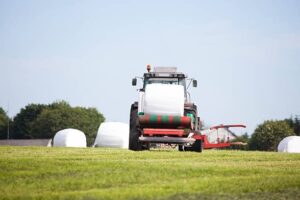The bale wrapper is a farm implement used to wrap the bales in plastic for silage. Various kinds of bale wrap include net wrap, BioNet, and silage wrap. All of them have benefits and disadvantages, and how you wrap the bales will vary depending on your needs.
Silage wrap
 Silage wrap is a material that can be used to protect a bale of hay from the elements. It has multiple layers, which provides excellent protection. There are several different types of silage wrap available on the market. The best type for your needs depends on your specific needs.
Silage wrap is a material that can be used to protect a bale of hay from the elements. It has multiple layers, which provides excellent protection. There are several different types of silage wrap available on the market. The best type for your needs depends on your specific needs.
Various manufacturers of silage wrap have varying thicknesses. A thicker film can provide better protection from hail. However, you must also select the correct movie for your particular needs.
Plastic twine
There are several different types of plastic twine used to bind bales. These are available in polypropylene, which is a strong and durable material. They are also available in sisal. In addition, natural twine is available and is made from plant fibres. The best choice for hay producers will depend on the area where the forage will be stored.
Polypropylene is the most common type of synthetic twine. It has properties that make it rot-resistant and rot-proof. However, it is not biodegradable. This means it will take years for it to decompose.
Another option is to use a net wrap. The net wrap can improve the water-shedding ability of a bale. Also, it is more uniform and stable in all storage conditions. This can save you money.
Net wrap
Net wrap for bale wrap is a great way to protect hay during transport and storage. It also reduces waste. A bale can be wrapped with sisal twine, plastic twine, or tube wrap. Each provides its advantages.
Bale netting is an excellent choice for many farming operations. It helps protect hay, reduce spoilage, and prevent the development of white mould. In addition, using a bale netting system can help farmers reduce costs and make the baling process faster.
The cost of net wrap for bale wrap depends on the number of bales wrapped and the type of netting used. Plastic mesh is more expensive than twine. Sisal twine is a natural alternative that offers resistance to insects and vermin. However, it may not last in humid climates.
BioNet
BioNet bale wrap is a biopolymer designed to help reduce the amount of hay and straw that goes to waste. Imperial College London PhD students developed it. They hope to commercialize the product within three to five years.
BioNet bale wrap is a food-grade biopolymer used to wrap hay and straw bales. The company hopes that the product will help farmers reduce their waste while increasing the nutritional value of their livestock.
The Imperial College Venture Catalyst Challenge (VCC) brought together Imperial research and students worldwide to develop innovative products and services. The program attracted over 170 applications. Ultimately, two teams developed bale wrap alternatives that were selected for further study.
Removing the bale wrap before feeding
Removing the bale wrap before feeding your livestock is a good idea and may also prevent health problems. However, while the net wrap helps keep the hay from rotting and reduces spoilage, it can also be dangerous if animals get a hold of it. Here are a few tips to help you remove it.
The first step to removing the bale wrap before feeding your livestock is to know what you are doing. The best way to do this is to learn how to remove the wrapping from round hay bales properly. There are several ways to go about this.
A hot knife is a great option when tackling a particularly tangled or frozen net wrap. These knives are found at your local home improvement store, like Lowe’s.
What Is Bale Wrap?
Bale wrap is used to protect bales of hay or silage. It is designed to keep rain or snow off bales. Traditionally, bales were wrapped with sisal twine or wire, but rats and rodents often chewed these materials. So today, plastic is used.
The Benefits of Bale Wrap
Bale wrap is an agricultural film used to protect bales of hay or other forage from the elements. Farmers and ranchers generally discard it after use. However, keeping a hay bale from absorbing moisture or getting spoiled can be beneficial.